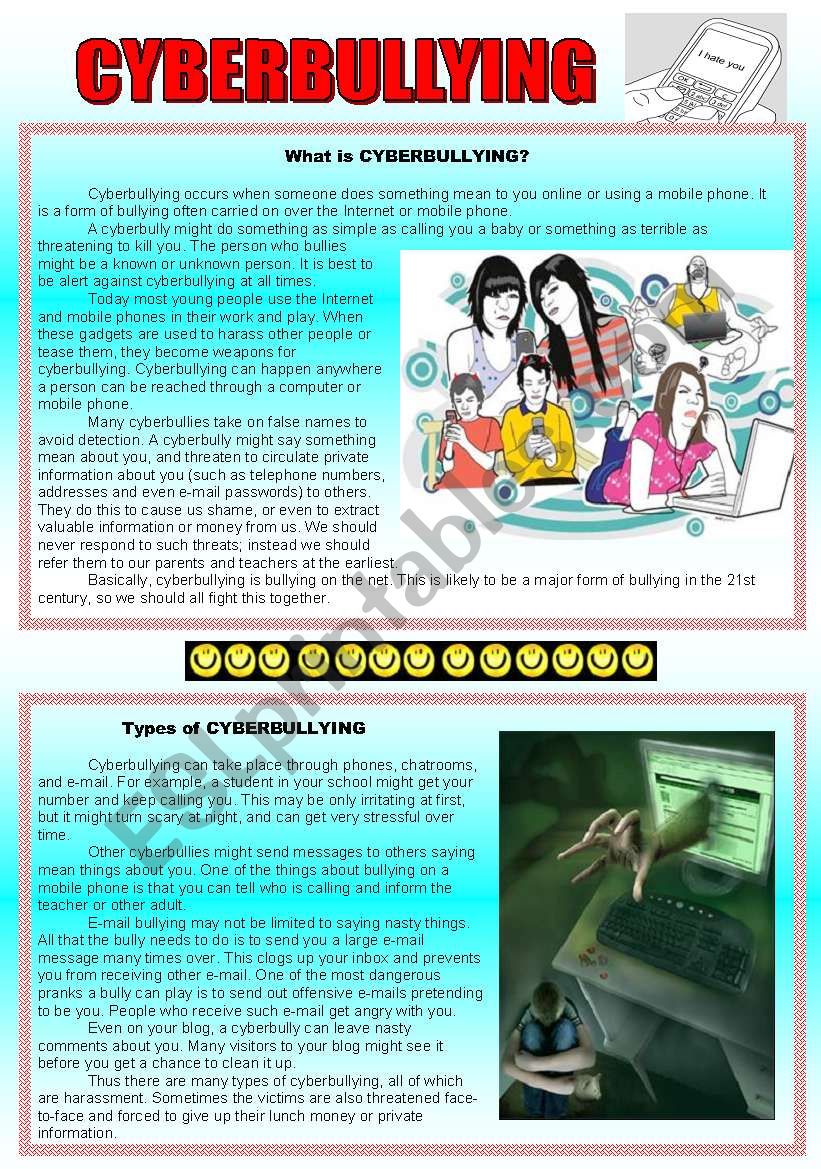What do we mean by cyberbullying?
Also, a motion was introduced in the Canadian House of Commons to propose a study of the scope of bullying in Canada, and for more funding and support for anti-bullying organizations. Todd's mother Carol established the Amanda Todd Trust, receiving donations to support anti-bullying awareness education and programs for young people with mental. Cyberbullying Scenarios A girl had her picture taken which made her feel uncomfortable. Later that week her friends tell her that the picture has been posted on another student’s blog. What should the girl do? Should she fight back? Scenario #1 Scenario #2 A boy has written a poem for his crush and decides to send it to her in a private message. Les Gray rejected claims that the SPFL board bullied or coerced clubs ahead of the vote. Claims that SPFL chief executive Neil Doncaster 'bullied' clubs into backing the plan to end the lower. Tell then that bullying other’s online is unacceptable behaviour which could get them into trouble with the school or police and they could end up losing friends. Teach by example Model and encourage positive behaviour in your child and praise them as they take this on board.
Facebook’s lack of enforcement around its call to arms policy exacerbated its failure to prevent violence in Kenosha, where, on the night of Aug. 25, armed right-wing militants heeded a call on Facebook to counterprotests against the police shooting of a 29-year-old Black man, Jacob Blake.
Cyberbullying Webquestmr. Mac's Page Shortcut
Cyberbullying means insulting, threatening, defaming or intentionally harassing other people using modern means of communication, usually for a long period of time.
Cyberbullying happens either on the Internet (e.g. by e-mail, instant messenger, social networks, videos on various portals) or by telephone (e.g. by WhatsApp or annoying calls). Most of the time, the culprit, referred to as “bully”, acts anonymously, so that the victim does not know from whom the attacks come.
Especially in cyberbullying among children and young people, victims and perpetrators also know each other in the “real” world. Victims almost always suspect who might be behind the attacks. Cyberbullying starts usually from people in the close environment: school, residential area, village or ethnic community. Cases involving complete strangers are very rare.
Important differences with “simple”, face-to-face bullying
- Cyberbullying is an intrusion into private life which takes place continuously and which does not end at the doorstep of the house (except when the new media are not used at home).
- The extent of the dissemination of information is not predictable because of the many possibilities and the speed of the new communication media.
- The perpetrators, the so-called “cyberbullies”, can act anonymously and often consider themselves safe because of this anonymity. In most cases, the presented identity of the perpetrator is very different from reality.
- Age or external image are not important criteria for cyberbullying. This can occur both between people of the same age (peers) and between people of different ages (student-teacher).
- There is the possibility of unintended cyberbulling as thoughtless actions without awareness of the consequences can be hurtful to the affected person. The perpetrator usually does not see these reactions and is not aware of the scale of the actions.
Since 1998, NCMEC has operated the CyberTipline, a place where the public and electronic service providers can report suspected online and offline child sexual exploitation. The millions of reports made each year uniquely situate NCMEC to identify trends and create prevention resources to address the evolving needs of kids and teens online.
NetSmartz is NCMEC's online safety education program. It provides age-appropriate videos and activities to help teach children be safer online with the goal of helping children to become more aware of potential online risks and empowering them to help prevent victimization by making safer choices on- and offline.
NetSmartz Videos
Videos for kids and teens explore cyberbullying, online exploitation, and more.
Watch now
#SafeOnline
Resources from the Department of Justice to keep kids safe online.
VisitBlog
Get child safety experts' take on today's tech, threats, and more.
Read MoreNetSmartzKids.org
Kid-safe site! Watch videos, play games, print coloring pages and more!
Visit NowTalk about Sexting
New 'Your Photo Fate' discussion guide.
Visit Now
Donate
Help fund critical programs like NetSmartz.
Learn More
Cyberbullying Webquestmr. Mac's Page Login
Shop
Shop the NCMEC store
VisitCyberbullying Webquestmr. Mac's Page Homepage
Free Resources
Download tipsheets, lesson plans, and other safety resources.
Cyberbullying Webquestmr. Mac's Page Sign In
View Now